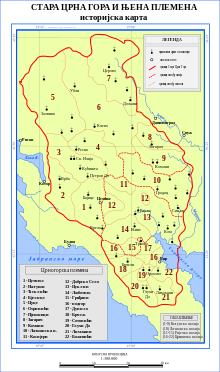Lješanska nahija

Lješanska nahija (Serbian Cyrillic: Љешанска нахија) is a historical region in eastern Montenegro. It was a nahija (sub-district) of the Ottoman Empire. In the administration of the Principality of Montenegro, the nahija was part of Old Montenegro, alongside Katun, Rijeka and Crmnica. The Serbian Gradac Monastery was once located within the region.
Lješanska nahija included the area to the Riječka nahija, and was the most impoverished and smallest part of the Principality of Montenegro, consisting of several brotherhoods, which due to some differences among them (especially religious) could not in its entirety establish itself as other tribes.[1] It was also home to the Albanian tribe of the Goljemadi.
The region was bordered by Lješkopolje, an Ottoman frontier which was not part of Montenegro prior to the Congress of Berlin (1878).[2]
Settlements
[edit]- Gradac
- Šteke
- Štitari
- Draževina
- Kornet
- Liješnje
- Orasi
- Relezi
- Podstrana
- Briđe
- Brežine
- Bigor
- Đalci
- Buronji
- Goljemadi
- Barutana
- Liješnje
- Donje Liješnje
- Begova Glavica
- Popratnica
History
[edit]The toponym derives from a Slavicized variant of the Albanian masculine name Lesh (Lješ). According to a local tradition, the ancestor arrived from the city of Lezhë, however the actual name is regarded as being much older since as early as 1496 Đurađ Crnojević mentions the nobleman Radovan Lъšević (Lješević) in the area of Lješanska nahija, while its inhabitants as Lьšane (Lješane).[3]
The name (Lješanska nahija) is first mentioned in 1692.[4] Traditionally, Vojvodas (The Dukes) came from the House of Uskoković.
Notable people
[edit]- Mardarije Kornečanin, Metropolitan of Cetinje (1637–59)
- Pavle Đurišić, leader of Montenegrin Chetniks in WW2
- Dejan Stojanović, Serbian poet, writer and essayist
- Stevan Raičković, Serbian poet, writer and academic
- Gojko Čelebić, Montenegrin writer and diplomat
- Vojislav Vukčević, Serbian politician and former minister of diaspora
- Sergej Ćetković, Montenegrin singer
- Simon Vukčević, Montenegrin footballer
- Marina Vukčević, Montenegrin handball player
- Dušan Vukčević, retired Serbian basketball player
- Dragiša Burzan, Montenegrin politician and diplomat
- Igor Burzanović, Montenegrin footballer
- Dragoljub Brnović, former Montenegrin footballer
- Branko Brnović, former Montenegrin footballer and current coach
- Bojan Brnović, Montenegrin footballer
- Nenad Brnović, Montenegrin footballer, brother of the above-mentioned Bojan
- Veljko Uskoković, retired Montenegrin water polo player
See also
[edit]References
[edit]- ^ Ferdo Čulinović (1954). Državnopravna historija jugoslavenskih zemalja XIX i XX vijeka: knj. Srbija, Crna Gora, Makedonija, Jugoslavija, 1918-1945. Školska knjiga.
Lješanska nahija obuhvatala je predio do Riječke nahije i to najsiromašniji i najmanji dio Crne Gore, nastanjeno sa više bratstava, koja se s obzirom na neke razlike među njima (naročito vjerske) nisu u cjelini ustalila kao ostala plemena.
- ^ Nićifor Dučić (1870). Primjetbe na "Komentar Gorskoga vijenca": Od arhimandrita N. Dučića. [Petar II Petrović Njegoš; Stjepan Mitrov Ljubisa]. [Dr.:] Drž. Stamparija. pp. 30–.
„Љешкопоље" није „„Љешанска нахија"", но је равница и око ње српска села у Зети у турској граници до „„Љешанске нахије""", која је у Црногорској граници.
- ^ Popović, Marija; Malja-Imami, Nailje R. (2021). "Albanizmi u srpskim i makedonskim govorima". Društvene & humanističke nauke. 4. State University of Novi Pazar: 97.
- ^ Srpski etnografski zbornik. Vol. 39. Akademija. 1926.
За назив Љешанска Нахија имали бисмо, колико нам је познато, први спомен у извештају Николе Ерице од 1692 го- дине.
